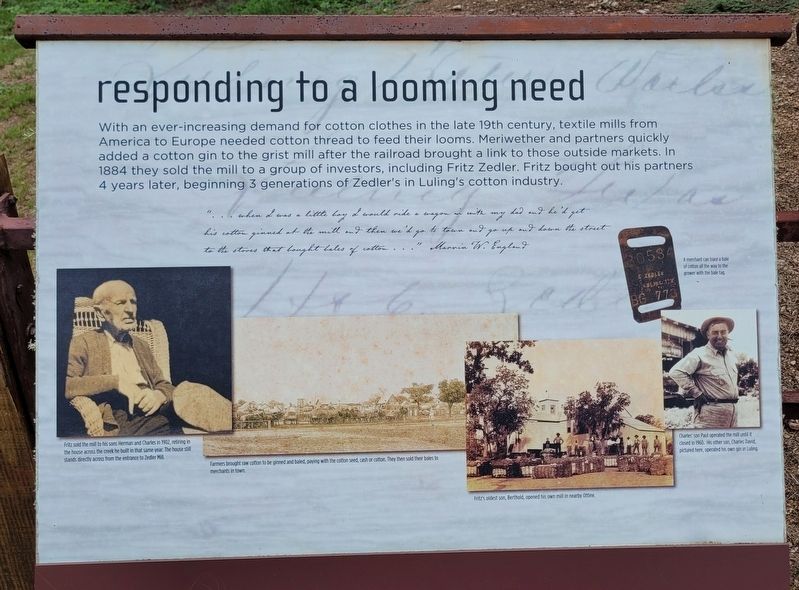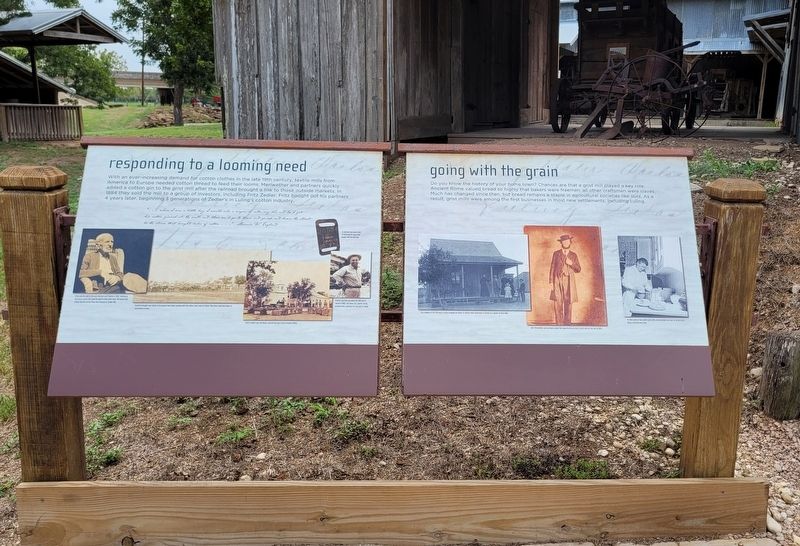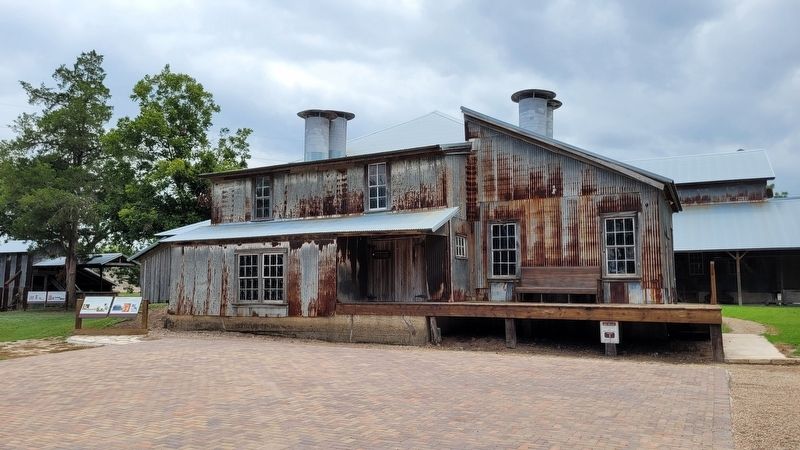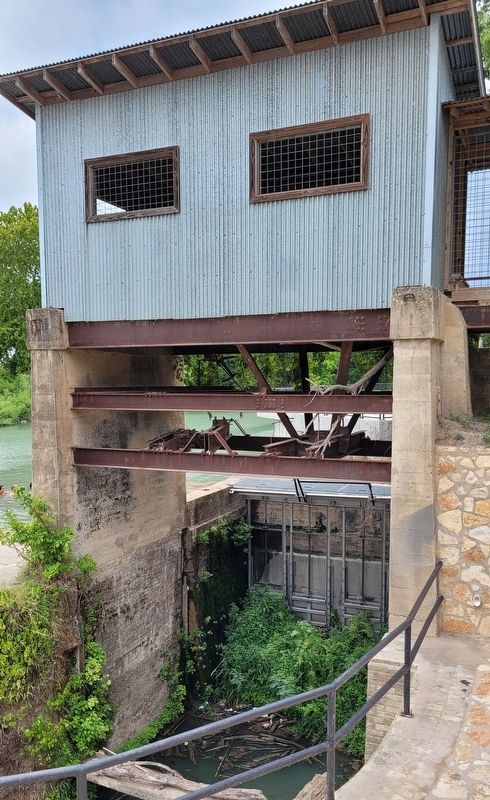Luling in Caldwell County, Texas — The American South (West South Central)
Responding to a Looming Need
"... when I was a little boy I would ride a wagon in with dad and he'd get his cotton ginned at the mill and then we I'd go to town and go up and down the street to the stores that bought bales of cotton..." Marvin W. England
Captions
Lower Left: Fritz sold the mill to his sons Herman and Charles in 1902, retiring in the house across the creek he built in that same year. The house still stands directly across from the entrance to Zedler Mill.
Lower Middle (L): Farmers brought raw cotton to be ginned and baled, paying with the cotton seed, cash or cotton. They then sold their bales to merchants in town.
Lower Middle (R): Fritz's oldest son, Berthold, opened his own mill in nearby Ottine.
Middle Right: A merchant can trace a bale of cotton all the way to the grower with the bale tag.
Lower Right: Charles' son Paul operated the mill until it closed in 1960. His other son, Charles David, pictured here, operated his own gin in Luling.
Erected by Zedler Mill Museum and Park.
Topics. This historical marker is listed in these topic lists: Agriculture • Industry & Commerce. A significant historical year for this entry is 1884.
Location. 29° 40.038′ N, 97° 39.072′ W. Marker is in Luling, Texas, in Caldwell County. Marker can be reached from the intersection of South Laurel Avenue and South Magnolia Street (State Highway 80). The marker is located in the central section of the Historic Zedler Mill Museum and Park. Touch for map. Marker is at or near this postal address: 1170 South Laurel Avenue, Luling TX 78648, United States of America. Touch for directions.
Other nearby markers. At least 8 other markers are within walking distance of this marker. Going with the Grain (here, next to this marker); Zedler's Mills (a few steps from this marker); The Same Old Grind (a few steps from this marker); From Boll to Bolt (a few steps from this marker); Capitalizing on the Need for Feed (within shouting distance of this marker); Mixing to Match (within shouting distance of this marker); Why Here? Why Then? (within shouting distance of this marker); The Lifeblood of Luling (within shouting distance of this marker). Touch for a list and map of all markers in Luling.
More about this marker. The Zedler Mill Park and its parking are free to the public daily. Donations are appreciated when visiting the Zedler Mill Museum.
Also see . . .
1. Zedler Mill Museum & Park. The City of Luling, Texas
In 1885, Bob Innes, John Orchard, J.K. Walker, and a German immigrant mill expert named Fritz Zedler, purchased the site and mill equipment naming it the "Luling Water Power Company". Soon they added a lumber sawmill and Fritz Zedler replaced the existing stone dam with a wooden dam and penstock that could generate more power. Buying out his three partners within a few years, Fritz Zedler became sole owner in 1888 and invited his oldest son, Berthold, to be his partner. Not long after the acquisition, the entire three story facility caught fire in October 1888 and was totally destroyed. The citizens of Luling promised to hold the sale of their cotton crops for the Zedlers to rebuild. Devastated, but not giving up, the Zedler family rebuilt the mill factory and within seven weeks, it was operational.(Submitted on September 1, 2022, by James Hulse of Medina, Texas.)
2. Cotton Culture. Texas State Historical Association
Increased cotton production led to technological improvements in cotton ginning-the process of separating cotton fibers from their seeds, cleaning the fibers, and baling the lint for shipment to market. In 1884 Robert S. Munger of Mexia revolutionized the slow, animal-powered method of "plantation ginning" by devising the faster, automated "system ginning," the process in use today. Cotton compresses, huge machines that reduced 500-pound bales to about half their ginned, or flat-bale, size for convenience in shipping, were constructed along railroad rights-of-way in many towns. The relocation of compresses from port cities such as Galveston to interior cotton-growing areas allowed farmers to sell their crops directly to buyers, who represented textile mills on the East Coast, and the buyers to send the cotton directly to the mills by rail rather than by ship. As telegraph lines spread westward, cotton could be bought and sold on the world market faster than ever before. Not only were the fibers sold, but also the cottonseed was crushed for cooking oil, hulls were converted to cattle feed, and portions of the plant were used to make an early type of plastic.(Submitted on September 1, 2022, by James Hulse of Medina, Texas.)
Credits. This page was last revised on September 1, 2022. It was originally submitted on September 1, 2022, by James Hulse of Medina, Texas. This page has been viewed 86 times since then and 11 times this year. Photos: 1, 2, 3, 4. submitted on September 1, 2022, by James Hulse of Medina, Texas.



